Explore Andy Warhol’s life—from his Pittsburgh roots to his career in New York City.
Andy Warhol was born Andrew Warhola on August 6, 1928, in a two-room apartment at 73 Orr Street in a working-class neighborhood in Pittsburgh, Pennsylvania. Carpatho-Rusyn immigrants from an area in the Carpathian Mountains in what is present-day Eastern Slovakia, his parents Andrej and Julia Warhola had three sons, Paul, John, and Andy, the youngest.

Unknown, Julia, John, and Andy Warhola, 1932
The Andy Warhol Museum, Pittsburgh; Founding Collection, Contribution The Andy Warhol Foundation for the Visual Arts, Inc.
1998.3.5247
In 1934, the family moved to their home at 3252 Dawson Street in Pittsburgh’s South Oakland neighborhood, which was closer to their church St. John Chrysostom Byzantine Catholic. Devout Byzantine Catholics, the family regularly attended mass and observed their Eastern European heritage.

Unknown, Andy Warhol's high school graduation photo, 1945
The Andy Warhol Museum, Pittsburgh; Founding Collection, Contribution The Andy Warhol Foundation for the Visual Arts, Inc.
1998.3.5219
As a child, Warhol suffered from Sydenham chorea, a neurological disorder commonly known as St. Vitus dance, characterized by involuntary movements. When the disorder occasionally kept him home from school, Warhol would read comics and Hollywood magazines and play with paper cutouts. Growing up in Depression-era Pittsburgh, the family had few luxuries, but Warhol’s parents bought him his first camera when he was eight years old.

Andy Warhol, View of Concert Hall, ca. 1948-1949
The Andy Warhol Museum, Pittsburgh; Founding Collection, Contribution The Andy Warhol Foundation for the Visual Arts, Inc.
© The Andy Warhol Foundation for the Visual Arts, Inc.
1998.1.1643
He attended elementary at Holmes School and took free Tam O’Shanter art classes at Carnegie Institute (now Carnegie Museum of Art) taught by Joseph Fitzpatrick, before attending Schenley High School in 1942. Recognizing his son’s talent, Andrej saved money to pay for Warhol’s college education, and he attended Carnegie Institute of Technology (now Carnegie Mellon University) from 1945 to 1949.

Unknown, Andy Warhol as a young boy, ca. 1936
The Andy Warhol Museum, Pittsburgh; Founding Collection, Contribution The Andy Warhol Foundation for the Visual Arts, Inc.
1998.3.5218
Health
Throughout his life, Warhol fixated on his physical imperfections. As a child, Sydenham chorea (St. Vitus dance) occasionally kept him bedridden, and he had pigment issues that caused discoloration of his skin, leading to the nicknames “Spot” and “Andy the Red-nosed Warhola.” In response to his perceived physical flaws, Warhol cultivated different looks through his clothing, wigs, cosmetics, and plastic surgery to change the shape of his nose. Later in his life he had premature baldness and massive scars from gunshot wounds suffered in 1968. His lifelong interest in beauty regimes and skin care made its way into his work, with early paintings depicting a nose job, wigs, and pain relief for corns. By the 1980s, Warhol had a near daily exercise regime and took vitamin supplements to improve his hair and skin; he incorporated bodybuilder imagery into his work and exercise equipment populates photographs of his studio.




































